Thermal Stability Analysis of Lithium-Ion Battery Electrolytes Based on Lithium Bis(trifluoromethanesulfonyl)imide-Lithium Difluoro(oxalato)Borate Dual-Salt
Abstract
1. Introduction
2. Materials and Methods
2.1. Materials
2.2. Differential Scanning Calorimetry (DSC) Measurement
2.3. Accelerated Rate Calorimetry (ARC) Measurement
2.4. Kinetic Analysis
2.4.1. Starink Method
2.4.2. FWO Method
3. Results and Discussion
3.1. Thermal Analysis Technology
3.1.1. Thermal Decomposition Analysis by DSC
3.1.2. Thermal Decomposition Analysis by ARC
3.2. Thermal Kinetic Analysis
3.2.1. Starink Method for Electrolyte Ea Calculation
3.2.2. FWO Method for Electrolyte Ea Calculation
3.2.3. Thermokinetic Parameters Determined by Autocatalytic Model
4. Conclusions
- The thermal behavior tests of the LiPF6 and LiTFSI-LiODFB dual-salt carbonate electrolyte by ARC and DSC indicated that the latter had better thermal stability. At 89.3 °C, the LiPF6 carbonate electrolyte conductive salt and moisture undergo an endothermic decomposition reaction to generate strong Lewis acids PF5, LiF, and trace moisture, accelerating the decomposition reaction. When the temperature exceeded 206.7 °C, the strong PF5 Lewis acid promoted the ring-opening polymerization reaction of low-volatility solvents, and the decomposition products of LiPF6 reacted with organic solvents. While LiTFSI-LiODFB dual-salt carbonate electrolyte was stable below 138.5 °C, the solvents began to decompose. The lithium salts decomposed successively when the temperature exceeded 271.0 °C.
- Starink, FWO kinetic models, and autocatalytic methods were used to calculate the Ea values of LiTFSI-LiODFB dual-salt electrolyte. The results showed that the values determined by the three methods were similar, with an average value of 53.25 kJ/mol. According to the simulation results, the mixed salt is considered to follow the autocatalytic model. The findings can provide a reference for the future application of dual-salt in different types of new lithium-ion batteries.
Author Contributions
Funding
Institutional Review Board Statement
Informed Consent Statement
Data Availability Statement
Acknowledgments
Conflicts of Interest
References
- Brutti, S.; Simonetti, E.; De Francesco, M.; Sarra, A.; Paolone, A.; Palumbo, O.; Fantini, S.; Lin, R.; Falgayrat, A.; Choi, H.; et al. Ionic liquid electrolytes for high-voltage, lithium-ion batteries. J. Power Sources 2020, 479, 228791. [Google Scholar] [CrossRef]
- Pham, H.Q.; Lee, H.Y.; Hwang, E.H.; Kwon, Y.G.; Song, S.W. Non-flammable Organic Liquid Electrolyte for High-Safety and High-Energy Density Li-ion Batteries. J. Power Sources 2018, 404, 13–19. [Google Scholar] [CrossRef]
- Li, W.; Liu, X.; Xie, Q.; You, Y.; Chi, M.; Manthiram, A. Long-Term Cyclability of NCM-811 at High Voltages in Lithium-Ion Batteries: An In-Depth Diagnostic Study. Chem. Mater. 2020, 32, 7796–7804. [Google Scholar] [CrossRef]
- Chen, S.; Wen, K.; Fan, J.; Bando, Y.; Golberg, D. Progress and future prospects of high-voltage and high-safety electrolytes in advanced lithium batteries: From liquid to solid electrolytes. J. Mater. Chem. A 2018, 6, 11631–11663. [Google Scholar] [CrossRef]
- Gaulupeau, B.; Delobel, B.; Cahen, S.; Fontana, S.; Hérold, C. Real-time mass spectroscopy analysis of Li-ion battery electrolyte degradation under abusive thermal conditions. J. Power Sources 2017, 342, 808–815. [Google Scholar] [CrossRef]
- Wang, Q.; Jiang, L.; Yu, Y.; Sun, J. Progress of enhancing the safety of lithium ion battery from the electrolyte aspect. Nano Energy 2019, 55, 93–114. [Google Scholar] [CrossRef]
- Ren, D.; Liu, X.; Feng, X.; Lu, L.; Ouyang, M.; Li, J.; He, X. Model-based thermal runaway prediction of lithium-ion batteries from kinetics analysis of cell components. Appl. Energy 2018, 228, 633–644. [Google Scholar] [CrossRef]
- Wang, Q.; Yao, Z.; Zhao, C.; Verhallen, T.; Tabor, D.P.; Liu, M.; Ooms, F.; Kang, F.; Aspuru-Guzik, A.; Hu, Y.-S.; et al. Interface chemistry of an amide electrolyte for highly reversible lithium metal batteries. Nat. Commun. 2020, 11. [Google Scholar] [CrossRef]
- Naoi, K.; Mori, M.; Naruoka, Y.; Lamanna, W.M.; Atanasoski, R. The Surface Film Formed on a Lithium Metal Electrode in a New Imide Electrolyte, Lithium Bis(perfluoroethylsulfonylimide) [LiN(C2F5SO2)2]. J. Electrochem. Soc. 1999, 146, 462–469. [Google Scholar] [CrossRef]
- Dahbi, M.; Ghamouss, F.; Tran-Van, F.; Lemordant, D.; Anouti, M. Comparative study of EC/DMC LiTFSI and LiPF6 electrolytes for electrochemical storage. J. Power Sources 2011, 196, 9743–9750. [Google Scholar] [CrossRef]
- Dahbi, M.; Ghamouss, F.; Tran-Van, F.O.; Lemordant, D.; Anouti, M. Ester based electrolyte with lithium bis(trifluoromethane sulfonyl) imide salt for electrochemical storage devices: Physicochemical and electrochemical characterization. Electrochim. Acta 2012, 86, 287–293. [Google Scholar] [CrossRef]
- Bolloli, M.; Alloin, F.; Kalhoff, J.; Bresser, D.; Passerini, S.; Judeinstein, P.; Leprêtre, J.-C.; Sanchez, J.-Y. Effect of carbonates fluorination on the properties of LiTFSI-based electrolytes for Li-ion batteries. Electrochim. Acta 2015, 161, 159–170. [Google Scholar] [CrossRef]
- Meng, N.; Zhang, H.; Lianli, S.; Lian, F. Salt-with-Salt, a novel strategy to design the flexible solid electrolyte membrane for highly safe lithium metal batteries. J. Membr. Sci. 2020, 597, 117768. [Google Scholar] [CrossRef]
- Matsumoto, K.; Inoue, K.; Nakahara, K.; Yuge, R.; Noguchi, T.; Utsugi, K. Suppression of aluminum corrosion by using high concentration LiTFSI electrolyte. J. Power Sources 2013, 231, 234–238. [Google Scholar] [CrossRef]
- Yang, H.; Kwon, K.; Devine, T.M.; Evans, J.W. Aluminum Corrosion in Lithium Batteries An Investigation Using the Electrochemical Quartz Crystal Microbalance. J. Electrochem. Soc 2000, 147, 4399–4407. [Google Scholar] [CrossRef]
- Li, J.; Xie, K.; Lai, Y.; Zhang, Z.A.; Li, F.; Hao, X.; Chen, X.; Liu, Y. Lithium oxalyldifluoroborate/carbonate electrolytes for LiFePO 4/artificial graphite lithium-ion cells. J. Power Sources 2010, 195, 5344–5350. [Google Scholar] [CrossRef]
- Zhang, S.S. An unique lithium salt for the improved electrolyte of Li-ion battery. Electrochem. Commun. 2006, 8, 1423–1428. [Google Scholar]
- Zhou, H.; Fang, Z.; Li, J. LiPF6 and lithium difluoro(oxalato)borate/ethylene carbonate + dimethyl carbonate + ethyl(methyl)carbonate electrolyte for Li4Ti5O12 anode. J. Power Sources 2013, 230, 148–154. [Google Scholar] [CrossRef]
- Li, F.; Gong, Y.; Jia, G.; Wang, Q.; Peng, Z.; Fan, W.; Bai, B. A novel dual-salts of LiTFSI and LiODFB in LiFePO4-based batteries for suppressing aluminum corrosion and improving cycling stability. J. Power Sources 2015, 295, 47–54. [Google Scholar] [CrossRef]
- Shangguan, X.; Jia, G.; Li, F.; Wang, Q.; Bai, B. Mixed Salts of LiFSI and LiODFB for Stable LiCoO2-Based Batteries. J. Electrochem. Soc 2016, 163, A2797–A2802. [Google Scholar] [CrossRef]
- Li, F.; Shangguan, X.; Jia, G.; Wang, Q.; Gong, Y.; Bai, B.; Fan, W. Dual-salts of LiTFSI and LiODFB for high voltage cathode LiNi 0.5 Mn 1.5 O 4. J. Solid State Electrochem. 2016, 20, 3491–3498. [Google Scholar] [CrossRef]
- Geng, Z.; Lu, J.; Li, Q.; Qiu, J.; Wang, Y.; Peng, J.; Huang, J.; Li, W.; Yu, X.; Li, H. Lithium metal batteries capable of stable operation at elevated temperature. Energy Storage Mater. 2019. [Google Scholar] [CrossRef]
- B, H.X.A.; B, P.S.; A, P.B.; A, X.C.; C, D.M.; D, M.E.B.; A, J.Z.; A, J.G.Z.; A, W.X. Enhanced charging capability of lithium metal batteries based on lithium bis(trifluoromethanesulfonyl)imide-lithium bis(oxalato)borate dual-salt electrolytes. J. Power Sources 2016, 318, 170–177. [Google Scholar]
- Zhang, L.; Ma, Y.; Cheng, X.; Zuo, P.; Cui, Y.; Guan, T.; Du, C.; Gao, Y.; Yin, G. Enhancement of high voltage cycling performance and thermal stability of LiNi1/3Co1/3Mn1/3O2 cathode by use of boron-based additives. Solid State Ionics 2014, 263, 146–151. [Google Scholar] [CrossRef]
- Liu, J.; Li, J.; Wang, J. In-depth analysis on thermal hazards related research trends about lithium-ion batteries: A bibliometric study. J. Storage Mater. 2021, 35, 102253. [Google Scholar] [CrossRef]
- Masoud, E.M.; Hassan, M.E.; Wahdaan, S.E.; Elsayed, S.R.; Elsayed, S.A. Gel P (VdF/HFP) / PVAc / lithium hexafluorophosphate composite electrolyte containing nano ZnO filler for lithium ion batteries application: Effect of nano filler concentration on structure, thermal stability and transport properties. Polym. Test. 2016, 56, 277–286. [Google Scholar] [CrossRef]
- Sloop, S.E.; Pugh, J.K.; Wang, S.; Kerr, J.B.; Kinoshita, K. Chemical Reactivity of PF5 and LiPF6 in Ethylene Carbonate/Dimethyl Carbonate Solutions. Electrochem. Solid-State Lett. 2001, 4, 357–364. [Google Scholar] [CrossRef]
- Masoud, E.M.; Emad, M. Citrated porous gel copolymer electrolyte composite for lithium ion batteries application: An investigation of ionic conduction in an optimized crystalline and porous structure. Journal of Alloys and Compounds: An Interdisciplinary. J. Mater. Sci. Solid-State Chem. Phys. 2015, 651, 157–163. [Google Scholar]
- ElBellihi, A.A.; Bayoumy, W.A.; Masoud, E.M.; Mousa, M.A. Preparation, Characterizations and Conductivity of Composite Polymer ElectrolytesBased on PEO-LiCIO4 and Nano ZnO Filler. Bull. Korean Chem. Soc 2012, 33, 2949–2954. [Google Scholar] [CrossRef]
- Feng, X.; Zheng, S.; Ren, D.; He, X.; Wang, L.; Cui, H.; Liu, X.; Jin, C.; Zhang, F.; Xu, C.; et al. Investigating the thermal runaway mechanisms of lithium-ion batteries based on thermal analysis database. Appl. Energy 2019, 246, 53–64. [Google Scholar] [CrossRef]
- Yeh, F.M.; Volli, V.; Laiwang, B.; Tung, P.H.; Shu, C.M. Oxidative stability and thermal performance of ester based lube oil with lithium salt additives. Appl. Therm. Eng. 2019, 150, 1328–1336. [Google Scholar] [CrossRef]
- Yazdani, A.; Sanghadasa, M.; Botte, G.G. Ionic conductivity and thermal stability of lithium salt / potassium bifluoride electrolytes for thermal batteries. J. Power Sources 2020, 453, 227854. [Google Scholar] [CrossRef]
- Ryou, M.-H.; Lee, J.-N.; Lee, D.J.; Kim, W.-K.; Jeong, Y.K.; Choi, J.W.; Park, J.-K.; Lee, Y.M. Effects of lithium salts on thermal stabilities of lithium alkyl carbonates in SEI layer. Electrochim. Acta 2012, 83, 259–263. [Google Scholar] [CrossRef]
- Lu, Z.; Yang, L.; Guo, Y. Thermal behavior and decomposition kinetics of six electrolyte salts by thermal analysis. J. Power Sources 2006, 156, 555–559. [Google Scholar] [CrossRef]
- Rder, P.; Baba, N.; Friedrich, K.A.; Wiemhfer, H.D. Impact of delithiated Li0FePO4 on the decomposition of LiPF6-based electrolyte studied by accelerating rate calorimetry. J. Power Sources 2013, 236, 151–157. [Google Scholar] [CrossRef]
- Röder, P.; Baba, N.; Wiemhöfer, H.D. A detailed thermal study of a Li[Ni0.33Co0.33Mn0.33]O2/LiMn2O4-based lithium ion cell by accelerating rate and differential scanning calorimetry. J. Power Sources 2014, 248, 978–987. [Google Scholar] [CrossRef]
- Parajó, J.J.; Teijeira, T.; Fernández, J.; Salgado, J.; Villanueva, M. Thermal stability of some imidazolium [NTf2] ionic liquids: Isothermal and dynamic kinetic study through thermogravimetric procedures. J. Chem. Thermodyn. 2017, 112, 105–113. [Google Scholar]
- Lin, C.P.; Tseng, J.M.; Chang, Y.M.; Cheng, Y.C.; Lin, H.Y.; Chien, C.Y. Green thermal analysis for predicting thermal hazard of storage and transportation safety for tert-butyl peroxybenzoate. J. Loss Prev. Process Ind 2012, 25, 1–7. [Google Scholar] [CrossRef]
- Zhang, Z.; Wang, C.; Huang, G.; Liu, H.; Yang, S.; Zhang, A. Thermal degradation behaviors and reaction mechanism of carbon fibre-epoxy composite from hydrogen tank by TG-FTIR. J. Hazard. Mater. 2018, 357, 73–80. [Google Scholar] [CrossRef] [PubMed]
- Botte, G.G.; White, R.E.; Zhang, Z. Thermal stability of LiPF6–EC:EMC electrolyte for lithium ion batteries. J. Power Sources 2001, 97–98, 570–575. [Google Scholar] [CrossRef]
- Kawamura, T.; Kimura, A.; Egashira, M.; Okada, S.; Yamaki, J.I. Thermal stability of alkyl carbonate mixed-solvent electrolytes for lithium ion cells. J. Power Sources 2002, 104, 260–264. [Google Scholar] [CrossRef]
- Vogdanis, L.; Heitz, W. Carbon dioxide as a monomer, 3. The polymerization of ethylene carbonate. Macromol. Rapid Commun. 1986, 7, 543–547. [Google Scholar]
- Haba, O.; Furuichi, N.; Akashika, Y. Anionic Ring-Opening Copolymerization of L-Lactide with a Five-Membered Cyclic Carbonate Having a Glucopyranoside Structure. Polym. J. 2009, 41, 702–708. [Google Scholar] [CrossRef]
- Gnanaraj, J.S.; Zinigrad, E.; Asraf, L.; Gottlieb, H.E.; Sprecher, M.; Aurbach, D.; Schmidt, M. The use of accelerating rate calorimetry (ARC) for the study of the thermal reactions of Li-ion battery electrolyte solutions. J. Power Sources 2003, 119, 794–798. [Google Scholar] [CrossRef]
- Cao, C.R.; Liu, S.H.; Das, M.; Shu, C.M. Evaluation for the thermokinetics of the autocatalytic reaction of cumene hydroperoxide mixed with phenol through isothermal approaches and simulations. Trans. Inst. Chem. Eng. Process Saf. Environ. Protect. Part B 2018, 117, 426–438. [Google Scholar] [CrossRef]
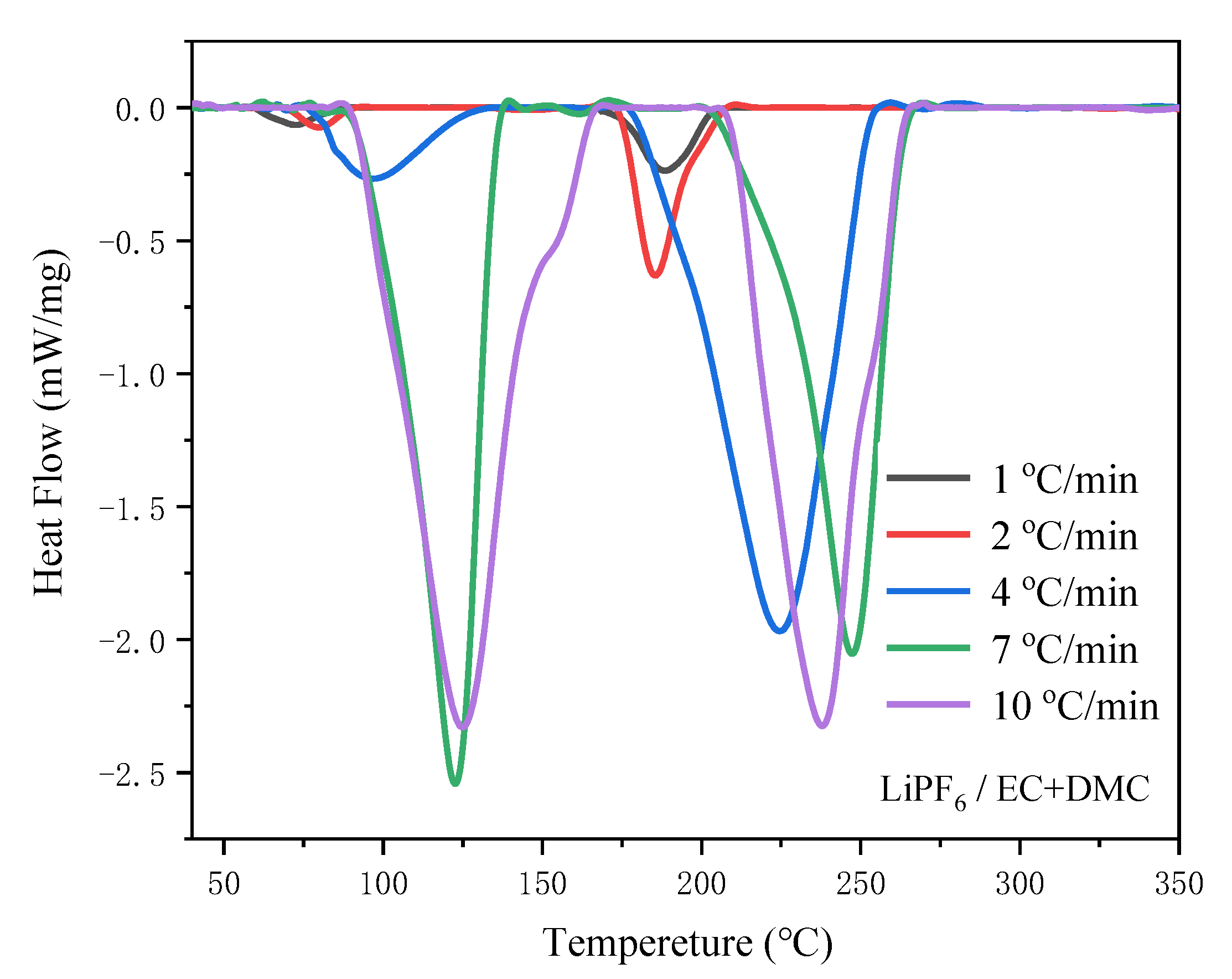
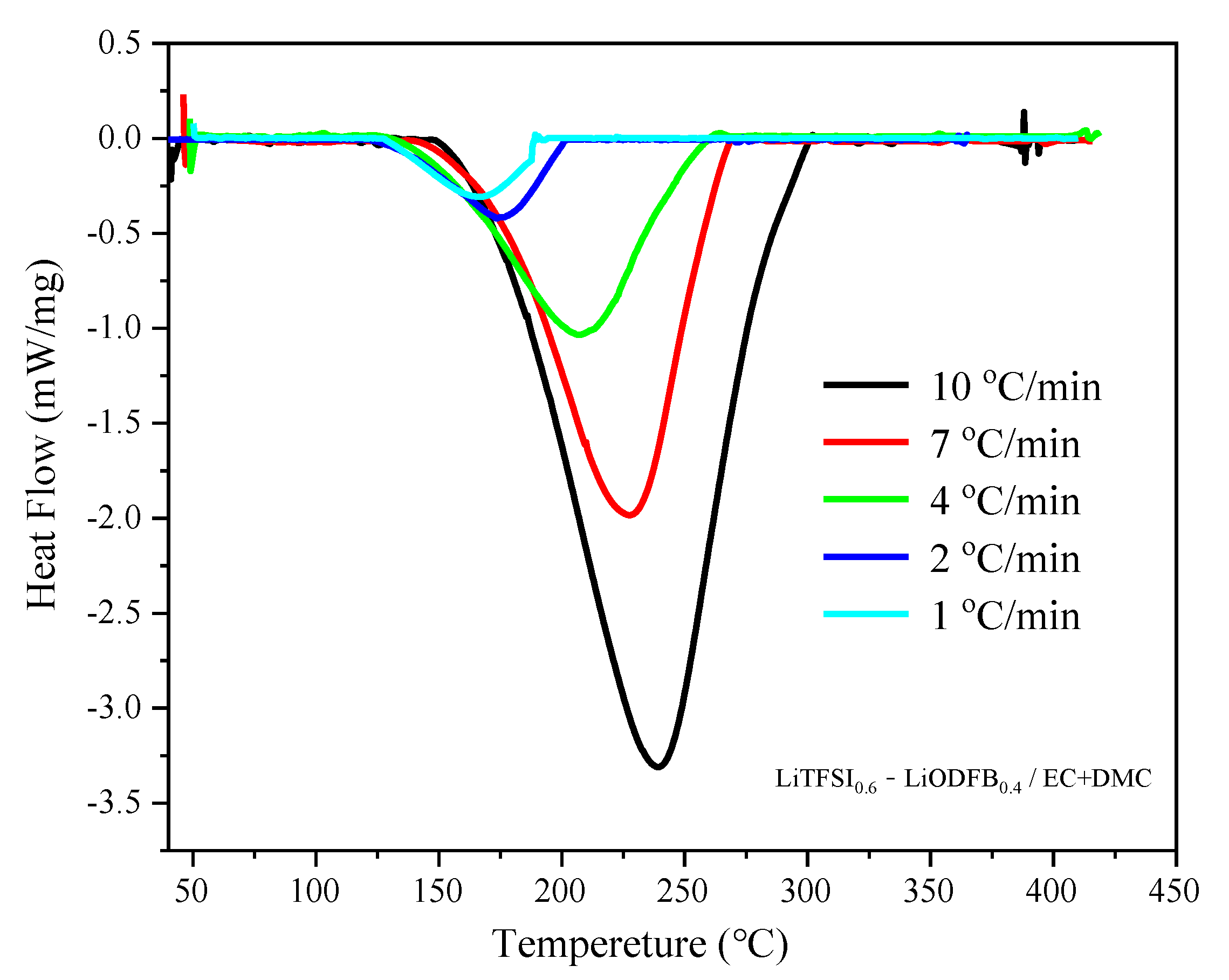
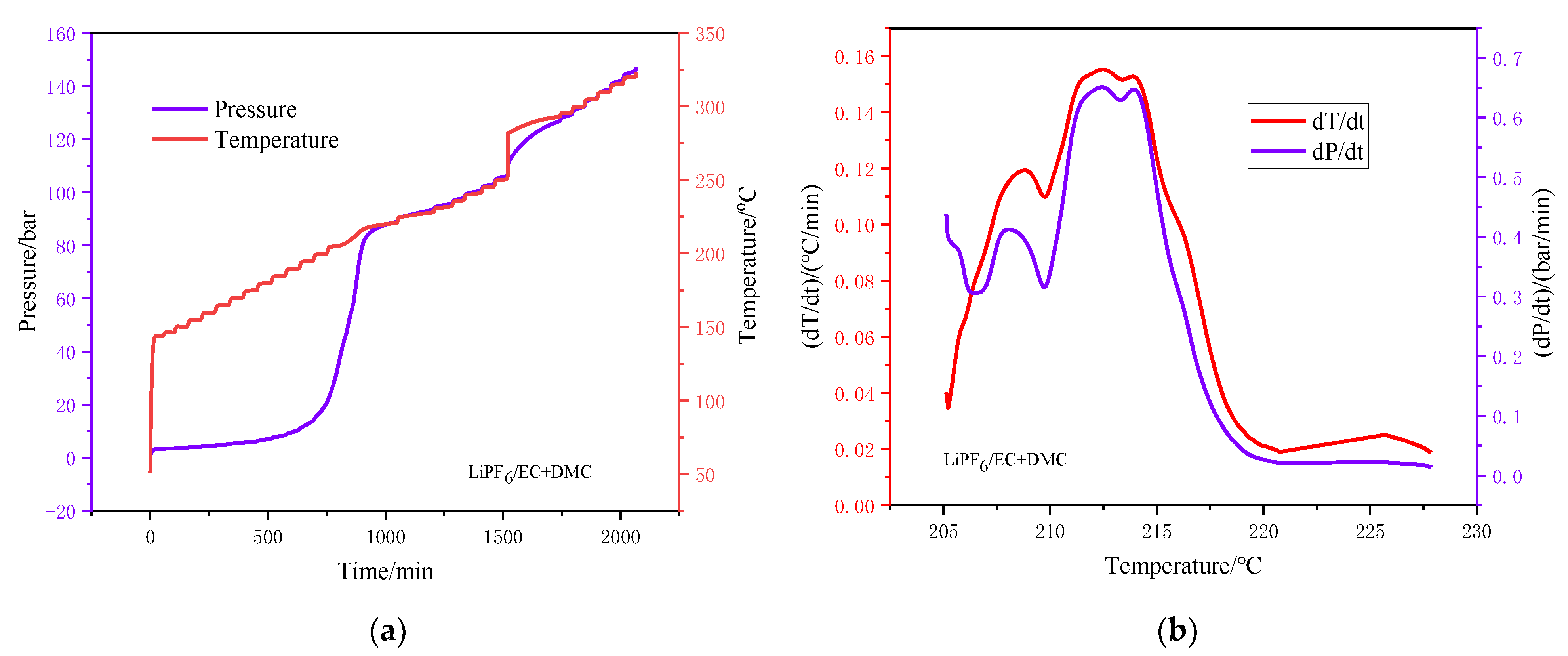
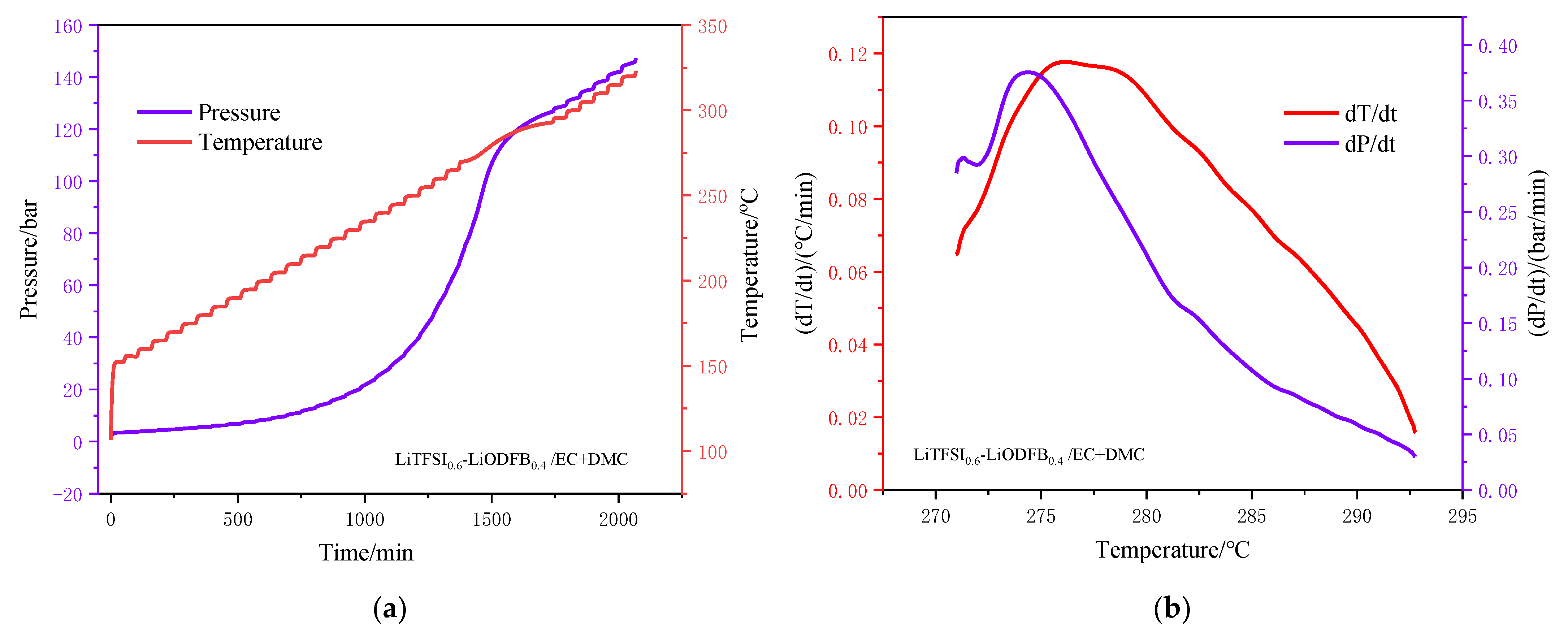
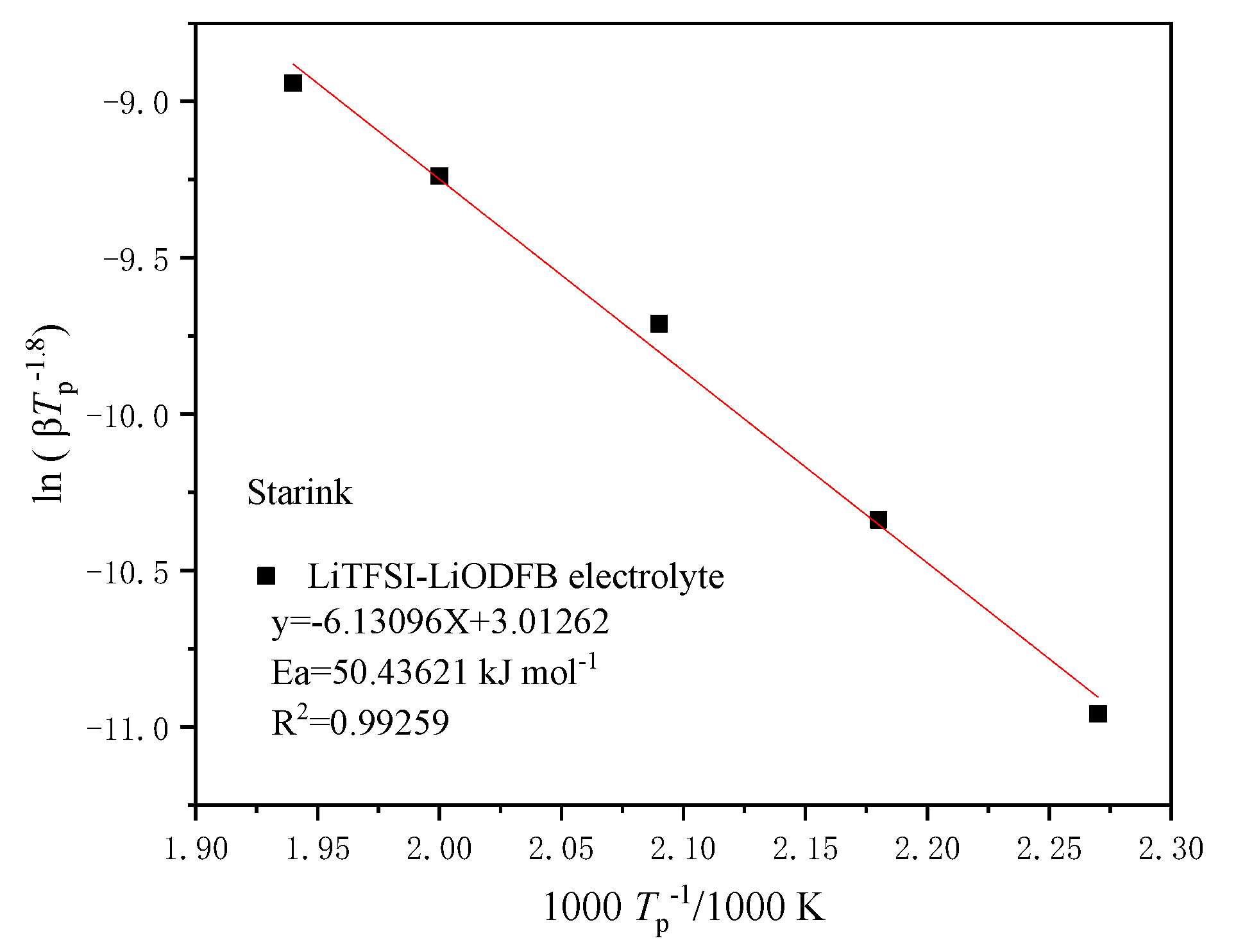
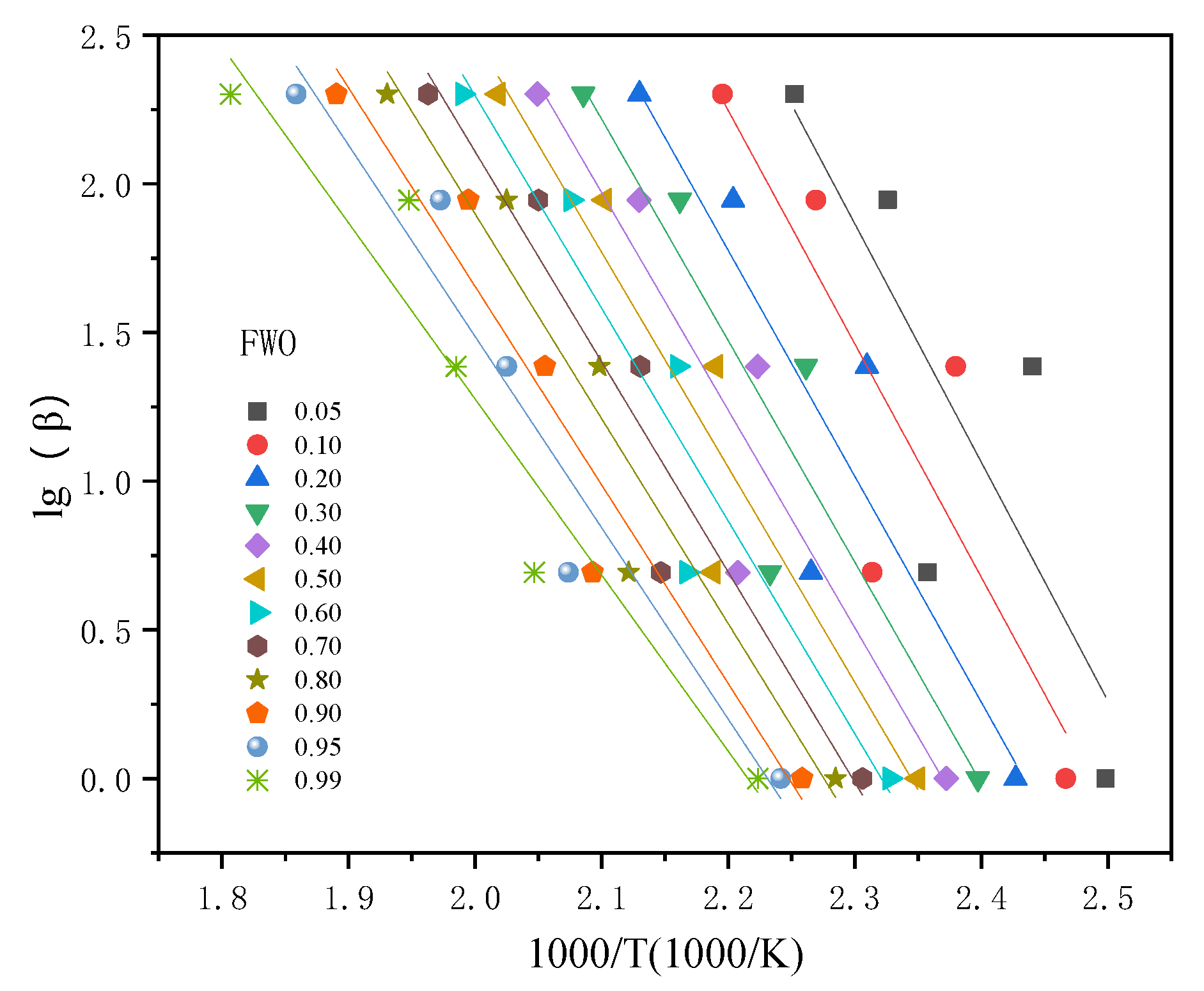
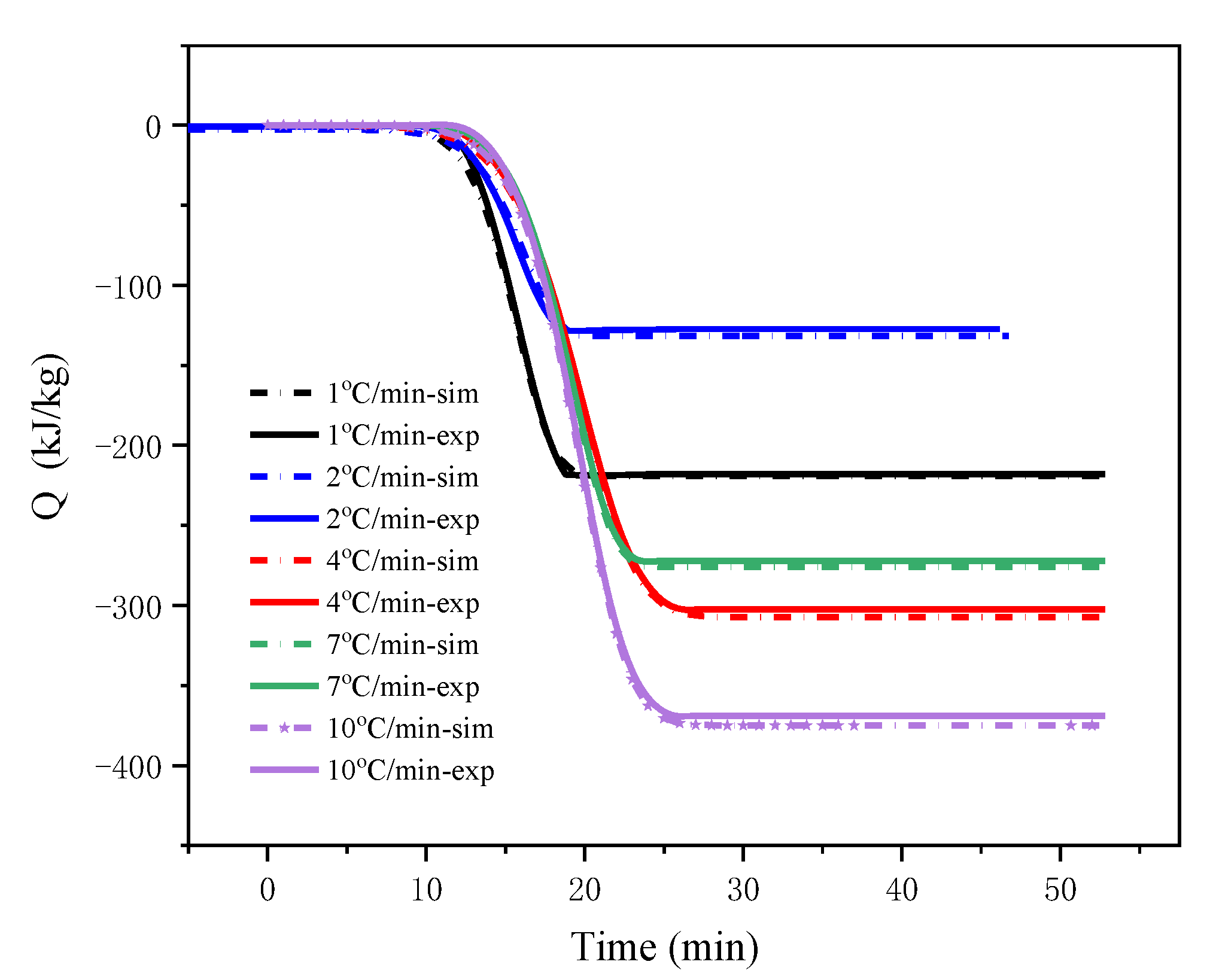
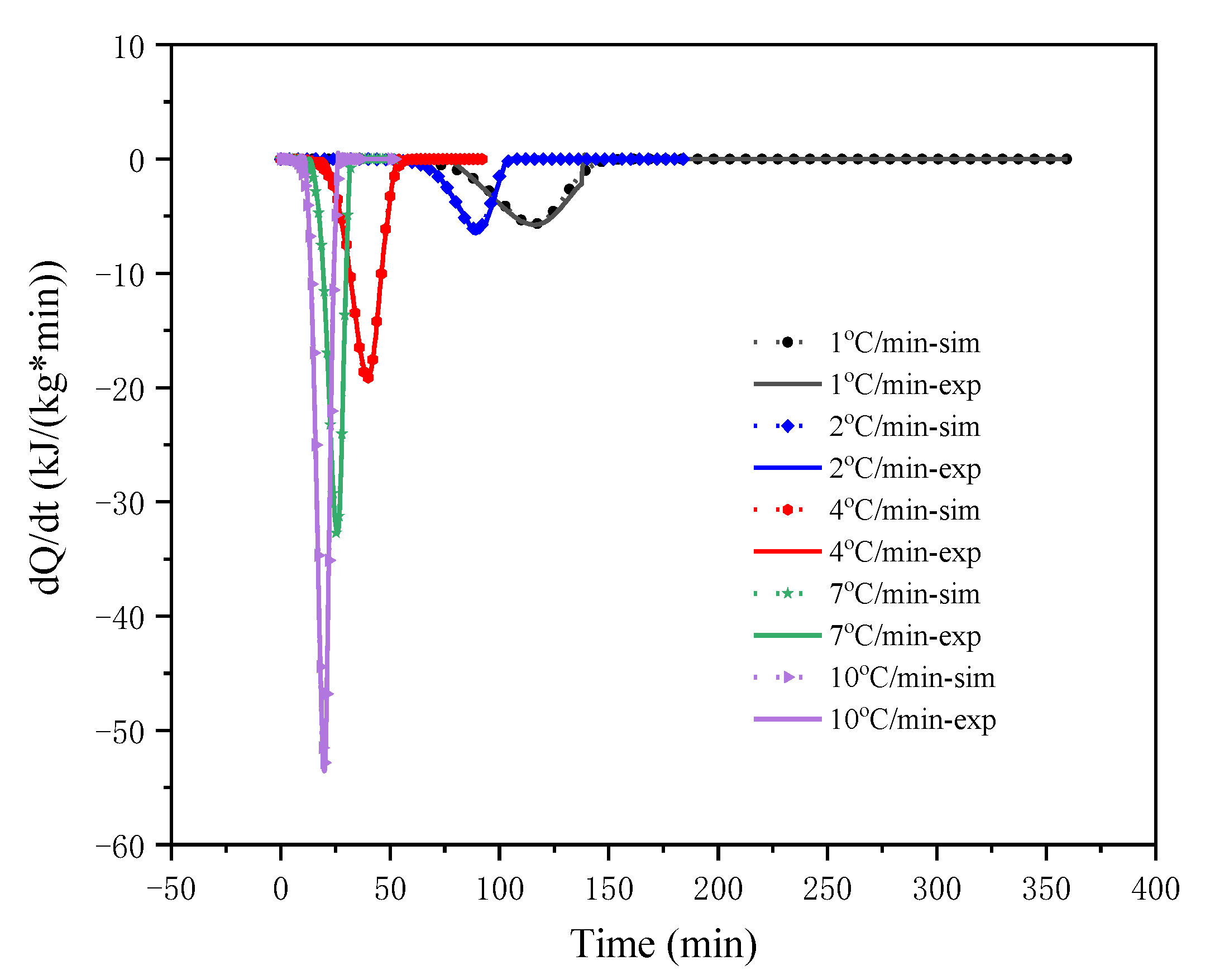
| Compounds | Chemical Formula | Boiling Point (°C) | Melting Point (°C) |
|---|---|---|---|
| EC | C3H4O3 | 248 | 38 |
| DMC | C3H6O3 | 91 | 0.5 |
| LiTFSI | C2F6LiNO4S2 | 190.5 | 234–238 |
| LiODFB | C2BF2LiO4 | – | – |
| LiPF6 | LiPF6 | – | 200 |
| Heating Rate (°C/min) | LiPF6/EC + DMC | LiTFSI0.6-LiODFB0.4/EC + DMC | |||||||
|---|---|---|---|---|---|---|---|---|---|
| Stage I (°C) | Stage II (°C) | ||||||||
| T0 | Tp | Te | T0 | Tp | Te | T0 | Tp | Te | |
| 1 | 60.9 | 72.3 | 88.1 | 167.6 | 188.5 | 209.4 | 113.7 | 167.2 | 185.5 |
| 2 | 67.7 | 81.33 | 92.0 | 173.3 | 205.3 | 208.0 | 108.0 | 185.6 | 223.6 |
| 4 | 76.0 | 99.7 | 137.0 | 176.7 | 224.6 | 255.3 | 110.0 | 204.8 | 242.4 |
| 7 | 79.5 | 123.9 | 137.9 | 201.3 | 247.5 | 266.7 | 129.6 | 226.4 | 254.5 |
| 10 | 89.3 | 125.0 | 167.3 | 206.7 | 253.3 | 265.3 | 138.5 | 243.5 | 294.0 |
| Sample | ms (g) | To,s (°C) | Te,s (°C) | (dT/dt)max (°C/min) | Ttem (°C) | (dP/dt)max (bar/min) | Tpre (°C) |
|---|---|---|---|---|---|---|---|
| LiPF6/EC +DMC | 2.311 | 205.1 1, 225.6 2 | 220.7 1, 227.84 2 | 0.15526 | 212.5 | 0.6510 | 212.4 |
| LiTFSI0.6-LiODFB0.4/EC+ DMC | 2.55 | 271.0 | 292.7 | 0.117 | 276.1 | 0.3754 | 274.3 |
| Methods | Starink | FWO | Autocatalytic Model | |
|---|---|---|---|---|
| Parameter | ||||
| Ea (kJ/mol) | 50.43 | 56.39 | 52.93 | |
| R2 | 0.992 | 0.879 | ‒ | |
| lnA | ‒ | ‒ | 7.8 | |
Publisher’s Note: MDPI stays neutral with regard to jurisdictional claims in published maps and institutional affiliations. |
© 2021 by the authors. Licensee MDPI, Basel, Switzerland. This article is an open access article distributed under the terms and conditions of the Creative Commons Attribution (CC BY) license (http://creativecommons.org/licenses/by/4.0/).
Share and Cite
Yang, Y.-P.; Huang, A.-C.; Tang, Y.; Liu, Y.-C.; Wu, Z.-H.; Zhou, H.-L.; Li, Z.-P.; Shu, C.-M.; Jiang, J.-C.; Xing, Z.-X. Thermal Stability Analysis of Lithium-Ion Battery Electrolytes Based on Lithium Bis(trifluoromethanesulfonyl)imide-Lithium Difluoro(oxalato)Borate Dual-Salt. Polymers 2021, 13, 707. https://doi.org/10.3390/polym13050707
Yang Y-P, Huang A-C, Tang Y, Liu Y-C, Wu Z-H, Zhou H-L, Li Z-P, Shu C-M, Jiang J-C, Xing Z-X. Thermal Stability Analysis of Lithium-Ion Battery Electrolytes Based on Lithium Bis(trifluoromethanesulfonyl)imide-Lithium Difluoro(oxalato)Borate Dual-Salt. Polymers. 2021; 13(5):707. https://doi.org/10.3390/polym13050707
Chicago/Turabian StyleYang, Ya-Ping, An-Chi Huang, Yan Tang, Ye-Cheng Liu, Zhi-Hao Wu, Hai-Lin Zhou, Zhi-Ping Li, Chi-Min Shu, Jun-Cheng Jiang, and Zhi-Xiang Xing. 2021. "Thermal Stability Analysis of Lithium-Ion Battery Electrolytes Based on Lithium Bis(trifluoromethanesulfonyl)imide-Lithium Difluoro(oxalato)Borate Dual-Salt" Polymers 13, no. 5: 707. https://doi.org/10.3390/polym13050707
APA StyleYang, Y.-P., Huang, A.-C., Tang, Y., Liu, Y.-C., Wu, Z.-H., Zhou, H.-L., Li, Z.-P., Shu, C.-M., Jiang, J.-C., & Xing, Z.-X. (2021). Thermal Stability Analysis of Lithium-Ion Battery Electrolytes Based on Lithium Bis(trifluoromethanesulfonyl)imide-Lithium Difluoro(oxalato)Borate Dual-Salt. Polymers, 13(5), 707. https://doi.org/10.3390/polym13050707







